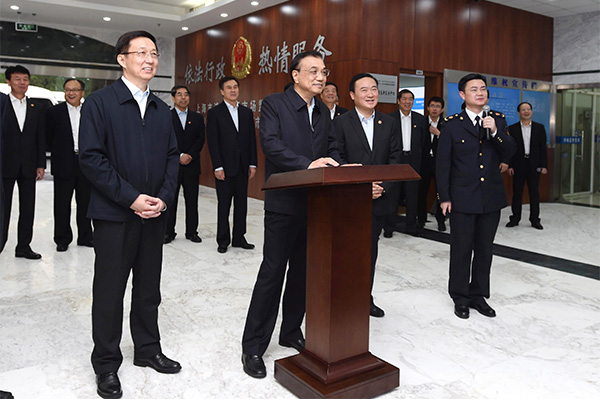
Premier Li Keqiang tries out an online platform by clicking the button to randomly choose a dozen staffers to inspect 27 food companies, during his inspection of the Shanghai Free Trade Zone on Nov 21, 2016.[Photo/Xinhua]
Shanghai Free Trade Zone (FTZ) is at the forefront of China’s tests to boost foreign trade and the economy.
Premier Li Keqiang pays close attention to the development of FTZs, and during the past four years, he has visited Shanghai’s FTZ each year.
Established in September 2013, the Shanghai FTZ was the first free trade zone in the world’s second-largest economy.
Months before it opened, Premier Li visited Shanghai and commented that the reform 30 years ago was led by special economic zones along the coastal regions, and now, as a new round of reform is taking place, Shanghai is able to take the lead.
“Setting up the Shanghai Free Trade Zone was not only to find out ways to better handle relations between government and market, test the mode of negative lists, and create more space for the market, but also to deal with relations between development and opening up, and further financial reform and innovation. Instead of becoming a policy and tax low, Shanghai FTZ should be created as a high bar of reform and innovation,” he said.
Three months after the Premier’s second visit in 2014, Shanghai FTZ gained new family members as free trade zones were created in Guangdong, Tianjin, and Fujian.
In 2015, Premier Li visited Shanghai FTZ again and stressed that the free trade zone should take the lead in tests to release the economic and development potential of reform and break down barriers on the way to reform.
In November, Premier Li visited Shanghai FTZ again after attending the 9th Global Conference on Health Promotion held in Shanghai, saying China is still the best place for foreign investment.
The FTZ tests gained momentum after the State Council decided in September to set up seven more free trade zones in Liaoning, Zhejiang, Henan, Hubei, Chongqing, Sichuan, and Shaanxi provinces.
Furthermore, the State Council released a circular on Nov 10 to guide nationwide application of test reforms that were successfully conducted in free trade zones.
One thing to be noted is the negative list, which was listed as the top guidance among the 19 items of reform experiences in the circular.
Since the publication of the first FTZ negative list, which stipulated regulations regarding market access for foreign investment, improvements have been made to reduce restrictions and increase openness and transparency.
On April 20, 2015, the State Council released a unified negative list for four FTZs and further reduced 17 items from 2014.
In addition to the negative list, the establishment of a single service window for foreign trade is another spotlight of institutional innovation in Shanghai’s FTZ, which created convenience for foreign trade.
The Premier said during his latest visit to Shanghai FTZ that in order to reverse the slowing growth of international trade, efforts should be made to provide convenience for international trade and promote reform and opening up.
